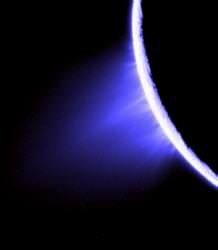Mark your calendars, this is going to be an amazing ride. NASA’s Cassini spacecraft is going to make a flyby of Saturn’s moon Enceladus on Wednesday, March 12, 2008. And this time, the spacecraft is going to fly right through the mysterious geysers of water ice blasting out of the moon’s Southern pole. At its closest approach, Cassini is going to get within 50 km (30 miles) of the surface. Now that’s close!
It was on a previous flyby that Cassini turned up evidence for the ice geysers in the first place. Images of the moon showed that huge plumes of water ice are pouring out of deep cracks around the moon’s southern pole. It’s believed that tidal interactions between Enceladus and Saturn are heating the moon’s interior. That heat has to escape, and this is how.
The particles really blast out of Enceladus, traveling at 1,285 km/h (800 miles per hour). The plumes expand out to distance three times as large as the moon itself. And this material even seems to be contributing to one of Saturn’s rings.
So on Wednesday, scientists will have an opportunity to get some of their questions answered. Cassini will fly on a trajectory that takes it through the edge of the plumes. At this point, it will be about 195 km (120 miles) above the surface. It will get even closer, skimming the moon at just 50 km (30 miles).
Although there will be pretty pictures, the main instruments used will be Cassini’s particle analyzers. These will study the composition of the plumes themselves – “sniffing and tasting” them.
“There are two types of particles coming from Enceladus, one pure water-ice, the other water-ice mixed with other stuff,” said Sascha Kempf, deputy principal investigator for Cassini’s Cosmic Dust Analyzer at the Max Planck Institute for Nuclear Physics in Heidelberg, Germany. “We think the clean water-ice particles are being bounced off the surface and the dirty water-ice particles are coming from inside the moon. This flyby will show us whether this concept is right or wrong.”
This will actually be the first of four Cassini/Enceladus flybys this year, and so if scientists don’t see what they’re looking for, there will be other chances.
Original Source: NASA/JPL Flyby Page


Way cool. I can hardly wait to see what they come up with. I hope Cassini’s wiper blades don’t need replacing.
I’m wondering, who’s “driving” Cassini? Does NASA have a Thomas Guide which optimizes these types of fly-bys? And what kind of propellant is onboard to make these corrections, and how long will it last before the mlssion goes “tilt?” Fifty kilometers above the surface of a moon! Now that’s a NMO (vs. a NEO) if there ever was one.
If, at just 30 miles above this moon’s surface, the intention is to just fly through the plums of mist for purposes of analysis, I hope that there are also plans to actually point the lens at the surface, this close, and take pictures of where exactly this curtain of steam is rising up from.
Imagine the sight of water gushing all the way up into space from the surface of a planet. 🙂
what if the geysers are so strong they knock the satellite off course and it goes crashing into saturn
“what if the geysers are so strong they knock the satellite off course and it goes crashing into saturn”
Then we’ll see some pretty amazing pictures from Saturn then…